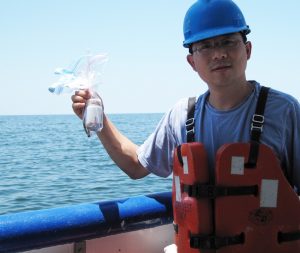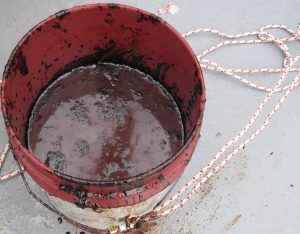Chemical Study Shows Different Patterns of Oil Weathering
– February 25, 2013
Scientists studying the weathering processes that altered the oil released during the Deepwater Horizon spill recently published their findings in the September 2012 Issue of Environmental Research Letters: The weathering of oil after the Deepwater Horizon oil spill: Insights from the chemical composition of the oil from the sea surface, salt marshes, and sediments. Understanding the chemical, physical, and biological processes involved is important in advancing research on the toxicity of weathering oil, its impact on coastal ecosystems, and for improving response to future events.
In this research, oil collected from the water’s surface (oil mousse) was found to be rapidly weathered during the transition to salt marshes within several days. The weathering processes might include evaporation, dissolution and biodegradation, although the quantitative importance of these processes remained unclear.
Analyses of oil in the sediment near the wellhead (collected a year after the spill) showed that the weathering processes altering this oil were slower than those at the surface. Oil deposited in sediments near the wellhead underwent a combination of dissolution and biological degradation processes. The authors suggest “this slow weathering might be caused by the low temperature, low oxygen concentration, and less microbial activity.”
For both surface waters and sediment, more weathering of the oil was observed as the sample sites got further from the wellhead. Additionally, as sampling distances increased, researchers found increasing levels of aluminum, iron, and manganese in the oil mousse. Scientists suggested that higher metal levels and suspended sediments, likely from the Mississippi River, were accumulated in the oil mousse as it travelled from the spill site towards the salt marshes.
Researchers also identified one petroleum compound, 3-methylchrysene, as the most stable among the compounds analyzed during the weathering of oil on the sea surface; they suggest that this compound may serve as a reference compound or “fingerprint” for this oil spill.
The study authors are Zhanfei Liu, Jiqing Liu, Qingzhi Zhu, and Wei Wu (Environmental Research Letters 2012 7 (3) 035302).
###########
This research was made possible in part by a grant from BP/The Gulf of Mexico Research Initiative (GoMRI) to the Dispersion Research on Oil: Physics and Plankton Studies (DROPPS) consortium. Other funding sources included the National Science Foundation Chemical Oceanography Program (OCE-1042908 to ZL) and OTIC (OCE-0752105 to QZ).
The GoMRI is a 10-year independent research program established to study the effect, and the potential associated impact, of hydrocarbon releases on the environment and public health, as well as to develop improved spill mitigation, oil detection, characterization and remediation technologies. An independent and academic 20-member Research Board makes the funding and research direction decisions to ensure the intellectual quality, effectiveness and academic independence of the GoMRI research. All research data, findings and publications will be made publicly available. The program was established through a $500 million financial commitment from BP. For more information, visit https://gulfresearchinitiative.org/.
© Copyright 2010- 2017 Gulf of Mexico Research Initiative (GoMRI) – All Rights Reserved. Redistribution is encouraged with acknowledgement to the Gulf of Mexico Research Initiative (GoMRI). Please credit images and/or videos as done in each article. Questions? Contact web-content editor Nilde “Maggie” Dannreuther, Northern Gulf Institute, Mississippi State University (maggied@ngi.msstate.edu).







